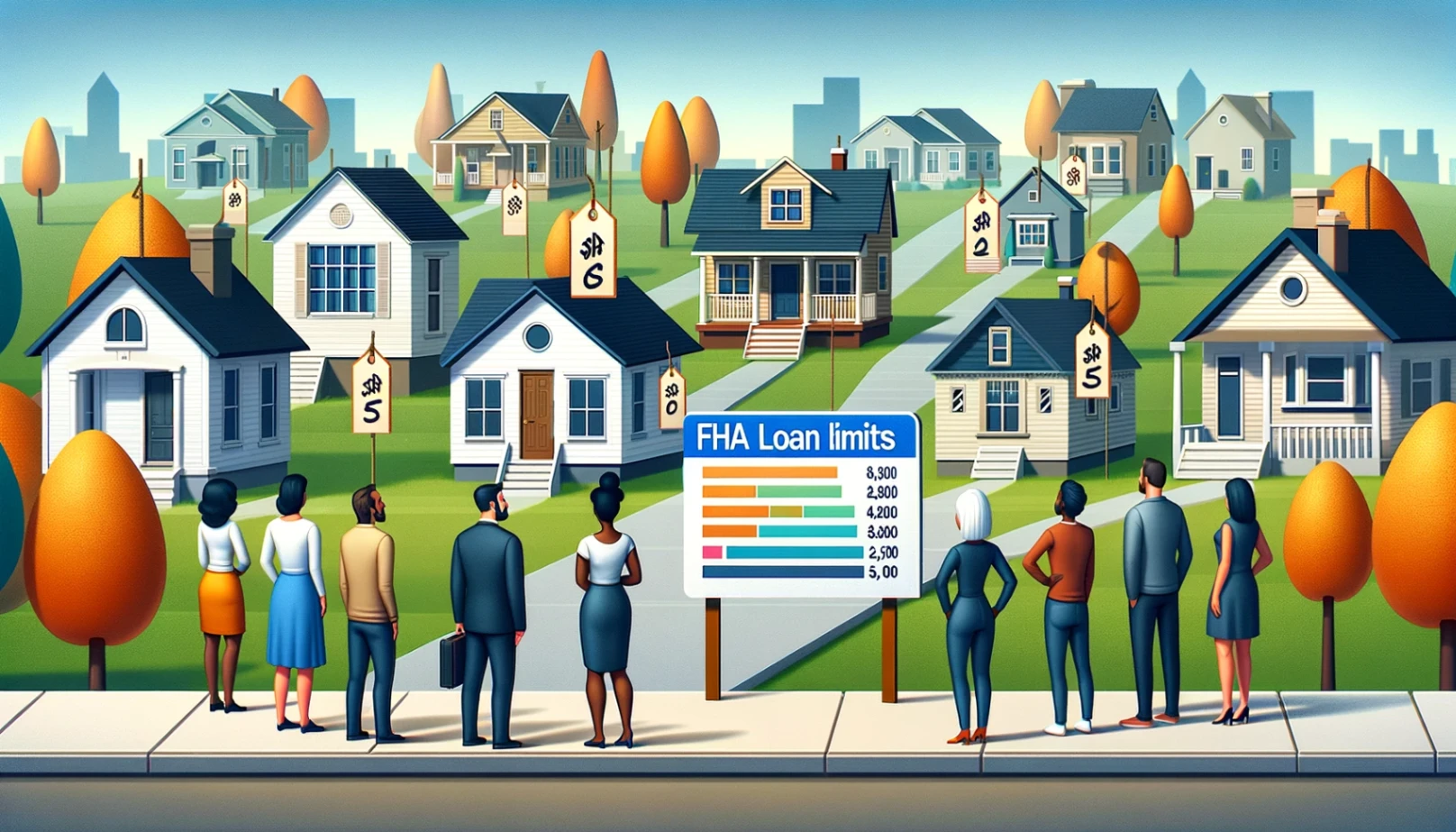In-home financing and FHA loan limits are pivotal factors. Understanding these limits is vital to making informed decisions when pursuing an FHA loan.
In this quick guide, we'll delve into the intricacies of FHA loan limits, shedding light on their importance and how they influence your homebuying journey.
What Are FHA Loans?
FHA or Federal Housing Administration loans offer accessible homeownership with low down payments and lenient credit requirements, benefiting first-time buyers and those with limited resources.
FHA loan insurance assures lenders, enabling better terms for borrowers.
Benefits of FHA Loans
FHA loans offer numerous advantages, making homeownership more attainable:
- Low Down Payment: A 3.5% down payment is required, ideal for first-time buyers.
- Lenient Credit Requirements: Accessible to borrowers with lower credit scores.
- Competitive Interest Rates: Often feature competitive rates, reducing financing costs.
- Higher Debt-to-Income Ratio: Allows flexibility for borrowers with existing debts.
- Assumable Loans: Future buyers can take over with lender approval.
- Financing for Home Repairs: FHA 203(k) loans cover buying and renovating.
- Protection for Lenders: FHA insurance benefits lenders, offering better terms.
- Streamlined Refinancing: Simplified process with minimal documentation.
Basic Eligibility Requirements
To qualify for an FHA loan, you must meet these essential criteria:
- Credit Score: Typically above 580, or 10% down with a lower score.
- Employment: Two years of steady employment.
- Income Verification: Stable income through documentation.
- Debt-to-Income Ratio: 43% or lower.
- Down Payment: 3.5% or 10% if the credit score is below 580.
- Residency: U.S. citizenship, permanent residency, or valid work visa.
- Property Standards: The home must meet FHA appraisal standards.
Meeting these criteria is crucial for FHA loan approval and achieving your homeownership goals.
FHA Loan Limits Explained
FHA loan limits are the maximum mortgage amounts insured by the Federal Housing Administration (FHA) in different U.S. regions, updated yearly based on local home prices.
They determine the maximum loan amount for FHA-backed mortgages, making homeownership accessible while considering regional real estate conditions.
Purpose of Loan Limits
FHA loan limits are crucial in the mortgage industry, ensuring fairness and accessibility. Here are the primary purposes behind their establishment:
- Ensuring Accessibility: FHA loan limits maintain affordability, allowing a broader range of borrowers, particularly first-time buyers, to access homeownership.
- Regional Real Estate Variation: These limits account for regional differences in home prices, ensuring FHA loans remain relevant and accessible in various markets.
- Risk Management: By capping loan amounts, FHA limits help mitigate risk for borrowers and lenders, promoting responsible lending practices.
How Loan Limits Are Determined
FHA loan limits are not arbitrary; specific criteria and calculations determine them. Here's a concise look at how these limits are established:
- Median Home Prices: FHA calculates limits based on the median home prices in each area, adjusting annually.
- Local Housing Market Data: HUD collects and analyzes data to assess the housing market's health and stability.
- Statutory Formulas: Congress provides guidelines, and HUD follows statutory formulas to set loan limits.
- High-Cost Areas: Certain regions with elevated home prices have higher loan limits.
- Notable Exceptions: FHA can grant exceptions for specific circumstances or market conditions.
Geographic Variations in Loan Limits
Geographic variations in FHA loan limits reflect diverse housing markets across the U.S., impacting homebuyers. Here's how limits differ by location:
- County Levels: Limits vary by county based on local home prices.
- Metro Areas: Major cities may have higher limits than rural regions.
- High-Cost Zones: California and the Northeast have higher limits due to pricey housing markets.
- Smaller Markets: Rural areas generally have lower limits due to lower home prices.
- Exceptional Cases: Alaska, Hawaii, Guam, and the U.S. Virgin Islands have higher limits due to higher living costs.
Why FHA Loan Limits Matter
Understanding why FHA loan limits matter is crucial for prospective homebuyers. These limits directly impact your home financing options, affordability, and the success of your homeownership journey.
- Affordability: FHA loan limits determine the maximum loan amount, impacting your ability to afford a home.
- Access to Financing: Limits ensure FHA loans remain accessible to various borrowers, especially first-time buyers.
- Regional Realities: Limits account for varying home prices in different areas, keeping FHA loans relevant.
- Avoiding Loan Denials: Staying within limits reduces the risk of loan denials or needing a higher down payment.
- Responsible Borrowing: Adhering to limits promotes responsible borrowing and prevents financial strain.
How to Find FHA Loan Limits
Locating FHA loan limits is a critical step in your homebuying journey. Here's a straightforward guide on how to find these essential figures:
- FHA Website: Visit the official FHA website for the most up-to-date FHA loan limits.
- HUD Offices: Contact your local U.S. Department of Housing and Urban Development (HUD) office for assistance locating your area's limits.
- Lender Consultation: Contact FHA-approved lenders who can provide information on loan limits specific to your location.
Following these steps, you can easily access the FHA loan limits relevant to your homebuying plans.
Exceptions and Special Cases
While FHA loan limits generally apply across the board, there are exceptions and exceptional cases to be aware of. These can significantly impact your home financing options. Here's an overview of some unique scenarios:
- High-Cost Areas: Certain regions with costly housing markets have higher FHA loan limits to accommodate local home prices.
- Multi-Unit Properties: Loan limits differ for multi-unit properties, such as duplexes or triplexes, allowing for larger loans.
- FHA 203(k) Renovation Loans: These specialized FHA loans provide financing for purchasing and renovating a home with a single mortgage.
Understanding these exceptions and exceptional cases ensures you can make the most informed decisions when considering FHA loans for your home purchase or refinancing needs.
Tips for Navigating FHA Loan Limits
Navigating FHA loan limits effectively is crucial for a successful home financing journey. Here are valuable tips to help you stay within these limits and make informed decisions:
- Financial Planning: Assess your budget and financial capacity to determine the right loan amount within FHA limits.
- Lender Expertise: Work with an experienced FHA-approved lender who can guide you through the process.
- Consider Alternatives: Explore alternative financing options or lower-priced properties if your desired home exceeds FHA limits.
These tips empower you to navigate FHA loan limits wisely and secure the right mortgage for your homeownership goals.
The Bottomline
In summary, FHA loan limits are crucial to your homeownership journey. Understanding their significance, staying within the bounds, and making informed choices empower you to use FHA loans effectively.
These limits exist to promote accessibility, making homeownership attainable for a wider audience.





